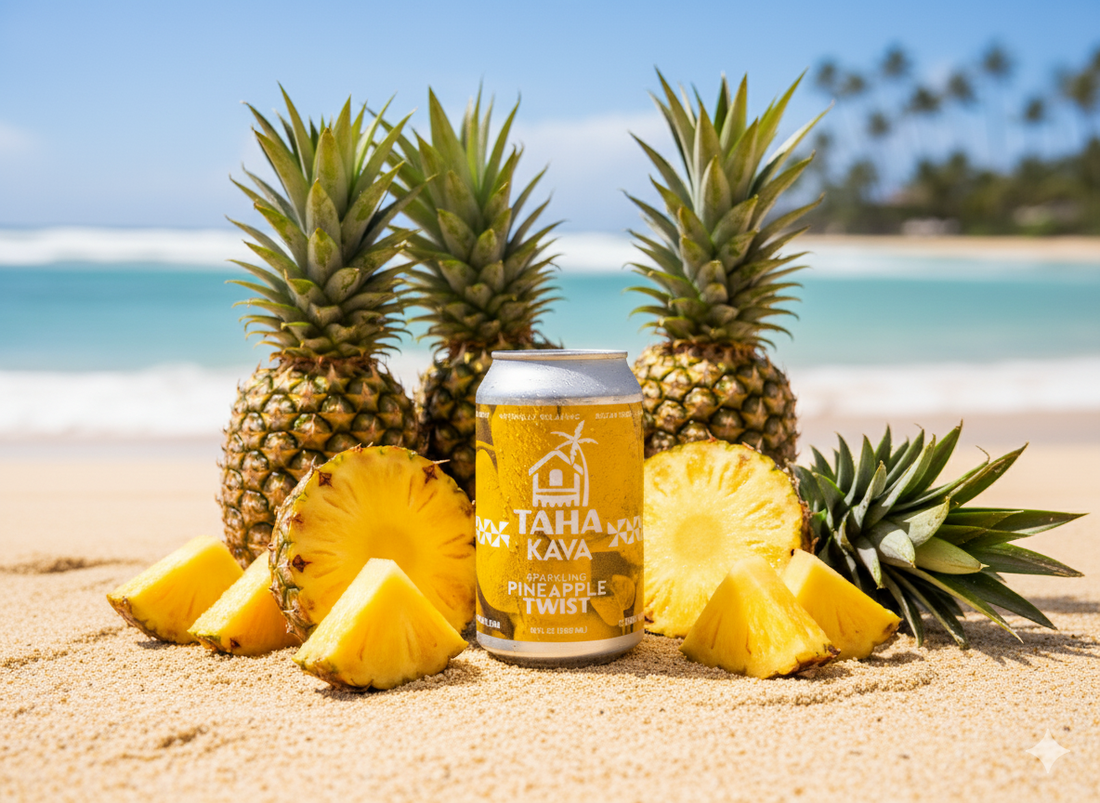This bright, tropical flavor was literally born inside the Pauwela Cannery on Maui’s North Shore A building that once housed a working pineapple cannery, part of Hawaiʻi’s booming pineapple industry. Today, instead of packing fruit into cans, we’re crafting cans of Taha Kava that connect people to tradition, flavor, and a healthier way to unwind.
Pineapple Twist is more than a drink. It’s a nod to the land, the history, and the generations of workers who once filled this cannery with the smell of sweet fruit and the rhythm of a thriving industry. And now, that same space is home to a new kind of craft, one that honors the past while looking toward the future.
So what’s the story behind pineapples in Hawaiʻi?
Let’s take a moment to honor the roots.
Hawaiʻi's Pineapple Legacy: From Exotic Crop to Cultural Icon
The Arrival of Pineapple in the Islands
While pineapples originated in South America, they made their way across the Pacific and were introduced to Hawaiʻi in the early 19th century. By the late 1800s, Hawaiian entrepreneurs were experimenting with pineapple as a commercial crop — but it wasn’t until the 20th century that things really took off.
Hawaiʻi’s tropical climate, fertile volcanic soil, and access to maritime shipping routes made it an ideal place for pineapple cultivation. Coupled with the invention of the Ginaca machine, a device that could peel and core 35 pineapples a minute, the industry scaled quickly.
Suddenly, canned Hawaiian pineapple was hitting shelves across the continental U.S., and Hawaiʻi became synonymous with sweet, golden fruit.
Maui’s Pineapple Era — A Local Industry Blooms
From Haʻikū to Lahaina
Maui played a pivotal role in pineapple history. In places like Haʻikū, Makawao, and Lahaina, pineapple fields sprawled across the landscape. Family names like Baldwin became synonymous with agriculture, and processing facilities began popping up to meet rising demand.
One of those facilities? The Pauwela Cannery — the very building where Pineapple Twist is now made.
In West Maui, operations like Maui Pineapple Company and Baldwin Packers helped anchor the local economy. Canneries provided jobs, pineapple became a way of life, and the fruit helped define Maui’s agricultural identity throughout much of the 20th century.
The Changing Tides
Over time, Hawaiʻi’s pineapple industry began to face challenges: rising land prices, global competition, and labor costs made large-scale production difficult to sustain. By the early 2000s, many of the island’s canneries had closed, and fields that once grew fruit were converted for other uses.
Still, pineapple didn’t disappear. Local farms like Hali‘imaile Pineapple Company kept the tradition alive, growing fresh fruit for the island and beyond under the Maui Gold label.
And some of the old cannery buildings? They found new life.
From Cannery to Kava: A New Chapter in Pauwela
“The Pauwela Cannery, once a bustling hub for pineapple processing, has found new life. Today it’s home to Pauwela Beverage Company, where Taha Kava is brewed alongside a vibrant mix of local businesses, from surfboard shapers to fine woodworkers.”
It’s a fitting home for Pineapple Twist. In a way, we’re still canning pineapple — just in a different form. One that blends:
-
Tradition: Kava has been shared in Polynesia for centuries.
-
Local Pride: Pineapple was once Maui’s signature crop.
-
Innovation: We’re combining the two into something modern, health-forward, and uniquely island-born.
Every time you sip a can of Pineapple Twist, you’re tasting a flavor shaped by the land — and a story rooted in the history of this place.
The pineapple fields may not stretch as wide as they once did, but their legacy lives on. It lives in the cannery walls, in the memories of Maui locals, and now in your can of Taha Kava.
Pineapple Twist is more than just a refreshing, tropical flavor. It’s a tribute. To the workers, to the farmers, to the buildings that once hummed with industry. And it’s a sign of what’s possible when we respect the past while crafting something new.

